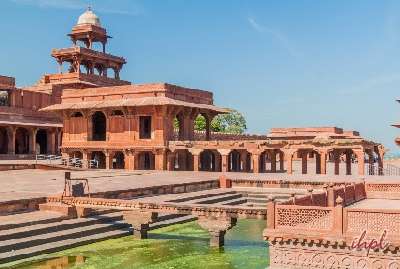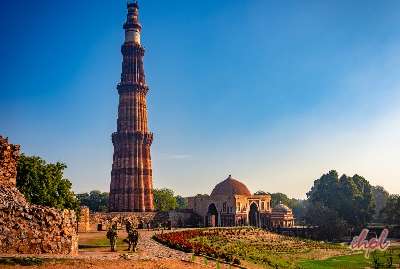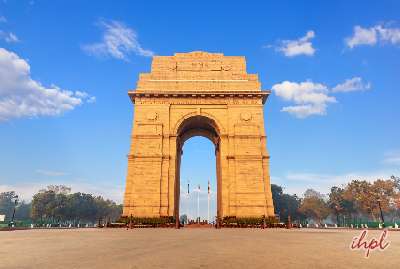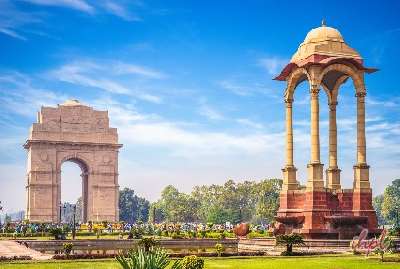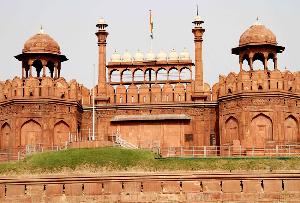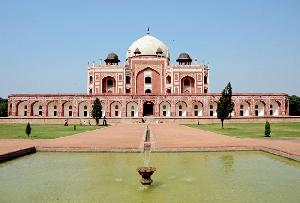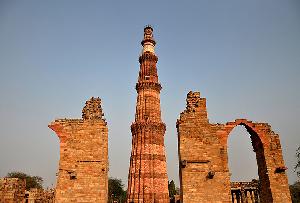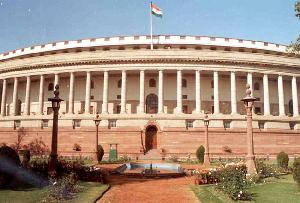Moth-ki-Masjid in Delhi was built by Miyan Bhuwa, who served as a minister during the rule of Sikandar Lodi in the 16th century. You will be able to spot Moth-ki-Masjid just behind South Extension Part II, an urban locale in the capital of India in Masjid Moth village.
This mosque will take you aback with the huge red sandstone gateway on the eastern side of the premise. The mosque itself is place on a raised platform. It has three domes, which unravels an important development in the evolution of of Mughal architecture because a dome added a new dimension to the aesthetic and architectural designs of building a mosque.
Even besides the dome, the mosque has a prayer chamber with five arched openings. The grand and elegant structure of the arches engraved with intricate designs including the mihrab with Quranic inscriptions in Naskh characters. The central arch built of red sandstone and decorated with marble, will draw your notice with its pristine color. You will also be impressed by the towers having two storey and arched openings on the roof. There are also octagonal chhatris with domes on the walls of the towers.
After you explore the interesting history of Moth-ki-Masjid in Delhi, you may also try out visiting nearby attractions in Delhi like Hauz Khas, Siri Fort, Kalkaji Temple, Lotus Temple, Nizamuddin’s Shrine, Chirag Dehlvi’s Dargah, South Extension Part II, Miyan Bhuwa, Sikandar Lodi.
History:
Moth-ki-Masjid in Delhi built by Miyan Bhuwa, one of the ministers of Sikandar Lodi in the 16th century, has a wonderful history that draws large number of tourists from across the country. History says that Moth-ki-Masjid was built by investing the revenue which was gained by from huge amount of crop that grew just from a single grain of moth (a kind of lentil).
Let us give you a feel of that time when Mughals were ruling a not-so-developed empire. As the political tension ebbed off and the administration was smoothly handled, the Mughals focused on honing their cultural, aesthetic and artistic potentials.
According to the history of Moth-ki-Masjid in Delhi, as Miyan Bhuwa was walking along Sikandar Lodi one day, Lodi suddenly presented him a lentil called Moth ka Dal after picking it up from the field. This gift triggered off a tumultuous though process in the minister’s mind who wanted to utilize the greatest potential that he could procure from the gift. The minister wanted to do the best justice possible to the King’s gesture. After a tussle in his mind, he finally decided at the dawn that he would sow the seed in the garden. He had hardly this idea that the sapling from the seed would grow up so fast and produce 200 grains in a year.
It so happened that with the passage of time, the country witnessed a green revolution. The yield from the grains was so high that the minister finally decided to invest part of the revenue in building a mosque. The mosque today stands as a note of celebrating the gift that Lodi had given the minister. Lodi himself was so contended with the minister that he named the mosque- Moth ki Masjid.
Fast – Facts:
Location:
Moth-ki-Masjid in Delhi is located in Masjid Moth village behind South Extension Part II.
Built By: Miyan Bhuwa, a minister of Sikandar Lodi
When was it was built: 16th century
Special Feature-
Learn about the history of Moth-ki-Masjid in Delhi which was formed from the revenue earned through the production of Moth-a kind of lentil.
How to Reach:
Tourists can either take local buses from various points within the city to reach the mosque, or they can hire auto-rickshaws and taxis or take the metro rail.
Nearest International Airport: Indira Gandhi International Airport
Nearest Metro Station: Central Secretariat
Nearest Railway Station: Nizamuddin Railway Station
Open: On all seven days of the week
Nearby Attractions:
As you visit Moth-ki-Masjid in Delhi, you will be taken away by the legend of lentil, a gift from Sikandar Lodi to his minister, which when sown reaped huge yield. You may also visit nearby attractions of Moth-ki-Masjid.
Hauz Khas means royal tank. Sultan Ala-ud-din Khilji , the founder of Siri, the second city of Delhi, dug a tank called Hauz-i-Alai in 1300. Along with the mosque and a tomb near by, the area came to be known as Hauz Khas.
Siri Fort has rubble-built walls, bastions and flame-shaped battlements. The city- Sir meaning head, was built by Sultan Ala-ud-din Khilji
Kalkaji Temple popular as Kalkaji Mandir and dedicated to Kalka Devi or Kali, draws large number of tourists during Navratri.
Lotus Temple or the Bahai House of Worship, is famous for its architecture. The temple is surrounded by lakes and gardens
Nizamuddin’s Shrine located in Nizamuddin village, is the shrine of Muslim saint, Sheikh Hazrat Nizamuddin Aulia Chishti.
Chirag Dehlvi’s Dargah– this dargah was built to venerate Nasuriddin Mohammed popular as Roshan Chiraf Dehlvi.
You can also visit Ansal Plaza on Khel Gaon Marg, South Extension Part I & II modern markets, Panchsheel Market, Nehru Place, Kalkaji Market, C R Park Market and Greater Kailash-1 Market.



